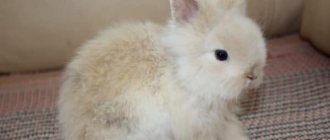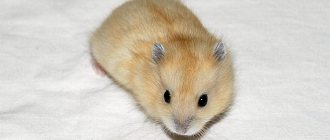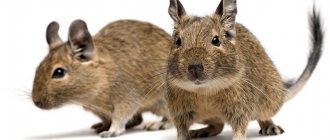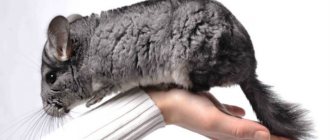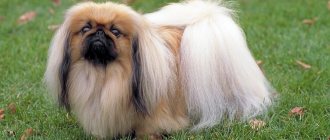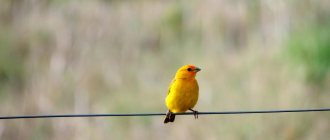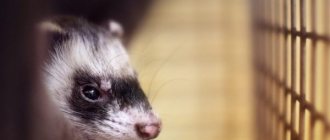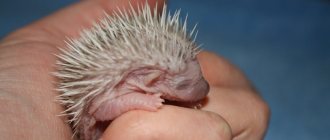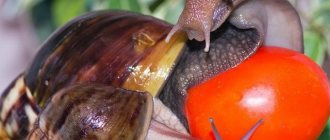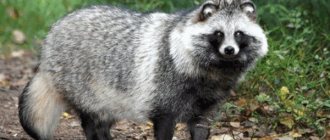How long do lop-eared rabbits and rams live?
September 26, 2013
Did you know that all domestic rabbits descended from one common ancestor - the European wild rabbit? It is currently found in Western Europe and the countries surrounding the Mediterranean. Man domesticated the wild rabbit. They tried to breed him in a variety of conditions: they fed him differently, and the selection was also different. As a result, man managed to create many cultural breeds of animals.
Of course, in the eighth century, domestic rabbits were the same color as wild ones. But among them, brownish, yellow, blue, white and black individuals have already begun to appear. The color changed as a result of mutation. And then the animals developed significant differences in body weight, hair type and ear length.
I wonder what a ram rabbit looks like? The common features of this species are long drooping ears and a hump-nosed ram's head. This breed is characterized by a dense build. But there are exceptions: the English ram, for example, has a long and slender body.
Decorative rabbit breeds were bred by breeders exclusively for home keeping. There are a lot of dwarf breeds nowadays. But fold-eared animals are especially loved by children and adults. They have funny little floppy ears. In fact, lop rabbits resemble tiny, touching lambs.
For this breed, the ideal weight is between 1300 and 2000 grams. These cute babes have a tight, compact body with rounded hips, short necks and thick, strong legs. A wide forehead and flattened cheeks are located on a flattened muzzle. And, of course, the ram rabbit has long ears, which delights the owners of furry pets. On average, the length of its ears ranges from 24 to 28 cm. Such a rabbit lives for about 14 years.
The lop-eared rabbit of the ram breed is distinguished by its peaceful character and fearless disposition. These animals are friendly, very playful and funny. But their females are more sociable and energetic than their males.
And French Ram rabbits were bred in 1850. It was believed that they originated from crossing German giants with lop-eared rabbits. As a result, a large fold-eared ram appeared. French rabbits are found primarily in agouti colors. They are a magnificent breed. This species also has beautiful fur.
French sheep are quite friendly and calm. But they are not suitable for living around small children. This animal is large in size. Its minimum weight is 5 kg, and the maximum has not yet been established. It requires too much space to move around. Such rodents are not suitable for cage keeping, but can live well in the house as a pet.
The domestic rabbit of the ram breed has been known to people for several hundred years. It is shown with two or one drooping ear in old images. Charles Darwin described lop-eared rabbits back in 1858. He wrote that an animal needs ears to catch sound or its direction. But under the protection of people, rabbits stop using this organ. And this symptom intensifies with each generation.
Rabbit breeds: Fold sheep
Rabbit Ram
Probably the cutest and most touching of the decorative rabbits can be confidently called the representative of the Ram breed - the lop-eared rabbit. The outline of this handsome guy's muzzle resembles the shape of a ram's head, which is why the breed got its name.
Representatives of the Lop-Eared Ram breed have a calm, friendly disposition and are a little timid, of course, thanks to their ears. Their drooping position and special shape muffle most external sounds.
Most often, these charming fold-eared “guys” can be found as decorative animals, although initially the breed is considered a meat breed.
At the initial stages, such drooping ears arose in animals through mutation, and breeders established this feature as a permanent feature of the Lop-eared sheep breed. Animals of English breeding have the longest ears; they can reach 50 cm.
Other varieties of the breed, besides the English one, are called the French and German Ram. French experts crossed the Fold ram with a giant rabbit, resulting in large representatives with good, thick hair and high growth rates. And German Rams arose from the crossing of English and French breed representatives.
Today it is rare to see lop-eared animals on large farms. The fact is that these rabbits are extremely sociable, love attention, and if it is not enough, they run wild and suffer from nervous disorders.
To keep a Lop-eared sheep at home, you will need a spacious crate, inside which the animal can move without constantly stepping on its own ears. The cage must have a solid bottom, without slats or cells. Otherwise, due to the heavy weight and inconvenience in the process of movement, rabbits suffer from pododermatitis - a paw disease that is difficult to treat.
Fold sheep on regular and fairly frequent walks.
Fold rabbits are thermophilic and perceive temperature changes negatively. If it is impossible to ensure a constant comfortable climate in the room where rabbits live, you should carefully insulate the cage where the animal lives.
You can feed rabbits of this breed while adhering to the general requirements of the species. In summer, dried herbs and concentrates are suitable for nutrition, in the cold season - hay, vegetables. Clean water for drinking must be present in the cage at all times - in sufficient quantity.
Fold rabbits are considered long-lived - they can live up to 12 years, provided that the owners provide him with proper attention and care.
Rabbit of the Lop-eared sheep breed, how to care for it? How long do they live?
The Lop eared sheep rabbit is a miracle that decorates the surrounding space. Decorative breed, bred in the twentieth century. Now it is very popular among animal lovers.
The lop-eared ram is distinguished from other breeds of rabbits by its long, soft, floppy ears. And his muzzle really does resemble a ram. Such a rabbit weighs from one and a half to two kilograms.
His character is sociable, sociable, he gets along well with children. But this same character can change towards aggression if the lop-eared ram does not receive proper care and attention. Therefore, find time to look after him and communicate. Then your rabbit will quickly remember your hands and his name.
- in combing the fur, especially if the rabbit is very fluffy;
- cleaning the ears is a must, they are sensitive in lambs;
- Before buying a rabbit, purchase a cage so that it is large and spacious, and make a house in it and put a drinking bowl. Attach a hay manger.
- the cage must be cleaned regularly, removing any remaining uneaten food;
- trim your claws every few months;
- Feed your fold sheep correctly. The main food is fresh hay. But add an apple, banana, carrot.
With good care, a decorative rabbit can live from eight to twelve years on average. And the record age is nineteen years.
More information can be found here and here.
the system chose this answer as the best
Breeding
Breeding dwarf fold rabbits is not difficult. Starting from 6 months of age, rabbits can reproduce safely. Fold rams are not particularly fertile. The female carries the rabbits for 28-36 days. With proper care, female rabbits can produce 6-7 rabbits in one litter.
A pregnant rabbit needs to be provided with maximum care. You need to keep the cage clean and give the animal more protein-rich, nutritious food.
Fresh, clean water is important for the female; it is recommended to give low-fat homemade cottage cheese and a hard-boiled egg once a day. In order for a mother rabbit to feed her babies for a long time, you need to disturb the animal as little as possible.
Sterilization and castration
At the onset of puberty, the ram rabbit begins to mark its territory and becomes restless and restless. Games with children are no longer interesting for the eared boy.
For females, the solution to the problem is sterilization, and for males, castration. After the operation, the ram becomes peaceful and calm. He is sleeping well, is interested in play again, and has a healthy appetite.
Starting from 4 months of age, females can be sterilized, but, according to many veterinarians, it is better to postpone the operation until 6 months of age, when the animal’s body becomes stronger and more mature and recovers faster after surgery.
The best age for castration of a male is 3.5-5 months. Experts do not give a definite answer as to whether it is possible to operate on individuals who have reached the age of 1-3 years. Most are inclined to believe that the operation is much more difficult for pets in this case. Before carrying out it, you must pass all the necessary tests and check the condition of the internal organs.
Fold sheep - dwarf decorative rabbits
A characteristic feature of the lop-eared sheep rabbit, unlike other decorative rabbits, is its ears hanging down. And with his head down, he resembles a small lamb. Hence the name of this breed of rabbits - dwarf lop-eared rams. Such pets are like a soft living toy; they are very docile and friendly. On this page of the Pet website we will tell you in detail about this rabbit. Most owners of such a rodent are simply crazy about their pets.
The ears of lop-eared rams are pressed to the muzzle and thickened at the base, the tips are smoothly rounded. Newly born rabbits, like other decorative rabbits, have ears that stick up. And only closer to the age of one month they begin to decline. And not necessarily at the same time. It happens that a cub walks for several months with one ear sticking out and one ear hanging down. But this doesn’t spoil him at all, he just has a funny, perky look.
In accordance with the standard of this breed, the length of the soft ears of an adult ram rabbit should be 24 - 28 cm. Fold ram rabbits are compact, densely built, with a large head.
Their paws are very small, the tail is pressed tightly to the body. Due to the very short neck, it seems that the massive head sits directly on the body. The animal's fur is fluffy and very pleasant to the touch. I want to pet this rabbit all the time. The fold-eared ram has large, expressive eyes. It is easier to look at the appearance in a photo in the text than to describe it in words. In accordance with the standard, the weight of such a pet should be 1.7 - 1.8 kg. They were obtained by crossing a large one, up to 6-8 kg. a rabbit of the French ram breed and a dwarf colored decorative rabbit. And only after 3 - 4 generations they managed to get miniature fluffies with hanging ears.
Appearance
The Netherland or Dutch Fold rabbit is the smallest of all sheep. It weighs only 1.5-2 kg and is up to 25 cm long.
The appearance of a typical representative of a decorative breed should fall under the following description:
- The head is wide, with a short blunt nose, a pronounced nape, a protruding forehead and large eyes.
- The ears are long, thick at the base and rounded at the tips. They are turned with their shells inward and hang down on both sides of the muzzle.
- The body is compact, cylindrical, with a short neck, massive chest, spherical back and short tail.
- The coat is short and soft. The color is blue, opal, red, white, cheetah, chinchilla, black and even sable.
French ram rabbit
Review: Rabbit of the Dwarf Fold Ram breed - An unusual pet
Tame, smart, unpretentious pet
It makes noise, gnaws, won't let you trim your claws, and sometimes it smells
For those who have decided to purchase this pet for their home, I can say that everyone will be delighted with its appearance, both household members and especially guests. There are many positive qualities, but problems also arise. In order: Of domestic rabbits, this is the kindest and most tame breed, as well as the smartest. When Sonya came to us, I was certainly surprised that the seemingly brainless animal went to the toilet in exactly one place, this solved the problems of smell and cleaning after it. It is necessary to place the tray in this place where he defecates and remove it as it gets dirty; we add wood filler. As for the other positive aspects: he responds to his name, goes to his hands, plays with the cat, is unpretentious in food: he loves to eat hay, special food, bagels, crackers, and you don’t have to throw away all sorts of skins from carrots, cabbage, etc. .now you have a home recycler! But you can’t overfeed and you need to always have fresh water.
Sources: fb.ru, xn—-8sbejdvowd3aos2cyc.xn--p1ai, www.bolshoyvopros.ru, pitomecdoma.ru, otzovik.com
Beetroot for rabbit food
Beetroot is an excellent food for many animals; it contains many vitamins, organic acids, microelements and fiber. However, it should be given to decorative rabbits.
What conditions do piglets need for rapid growth?
Tatyana Skofenko Student, on the vote 6 years ago Voting for the best answer Anna Kalyuzhnaya The Thinker 6 years ago The first six weeks of a piglet’s life are.
Onions with honey cough recipe
These products help cure cough very quickly and strengthen the internal strength of your body. Honey with onions for coughs in folk recipes.
Breeds of rabbits for backyard breeding in central Russia
The Viennese Blue rabbit breed was developed by simply reproductively crossing small pure blue rabbits with Flanders rabbits, in .
How to cook pork in foil in the oven
Pork baked in foil and oven turns out tender and flavorful. The recipe is quite simple and what’s great is the ability to use.
Holstein cow
May 8, 2021 All cattle bred today are divided into two large groups: dairy and meat productivity. Of course, in .
Marinade for lamb loin
Grind a pinch of cumin, coriander and black pepper in a mortar. Mix with salt. Add chopped garlic. Grind again. Rub this.
Keeping nutria at home
The business of breeding nutria at home cannot be called new, but at the same time, the market is not oversaturated with this type.
Duck recipes
Cooking duck is often timed to coincide with some kind of holiday. On the other hand, when roasted duck appears in your house, baked duck.
The influence of breed on the life expectancy of rabbits
In nature, rabbits live shorter lives than their decorative counterparts. They constantly fight for survival and are very likely to become the prey of a predator.
Some veterinarians believe that breed does not affect the number of years. But still, average indicators were derived for each breed of this pet.
Dwarf
It is impossible to give an exact figure in response to the question of how long these animals live. But there are averages. Rabbits of this breed can live about 10-12 years at home .
Compared to rabbits, which naturally have a lifespan of only a year or two. A record was recorded when a dwarf decorative rabbit lived up to 18 years at home.
Fold
The average lifespan of lop-eared decorative rabbits is slightly longer than their counterparts with erect ears - 7-8 years . Fold rabbits are less cowardly, so they cannot die from stress caused by a sudden fright. There is also an observation that the smaller the animal, the less it lives.
Wild individuals
If a wild rabbit was born and lived in natural conditions, and was then taken home, then the likelihood that the pet will live a long life is extremely low. They usually live to be two years old, but with proper care can live 5-10 years .
If you don’t know how to make flower beds from scrap materials, then look here.
How to make a compost pit is described in this article.
Advantages and disadvantages of content
Ram rabbits get along well with both adults and children, due to which they quickly win everyone's love. However, their maintenance is accompanied by a number of rules and requirements that must be met to maintain good pet health and the desired productive qualities.
- Keeping lop-eared animals has the following advantages:
- good adaptation of animals to various environmental conditions;
- calm, balanced and peaceful character;
- relative ease of care;
- unpretentiousness in nutrition;
- rapid growth and weight gain.
- Meanwhile, keeping a sheep rabbit at home has a number of difficulties:
- high susceptibility of animals to various infectious and viral diseases;
- low immunity of rams;
- regular mandatory hygienic procedures for caring for your pet, in particular, combing the fur, removing wax from the ears, trimming claws, etc.;
- daily games with a pet: a rabbit needs games and communication every day, so if he is deprived of care for a long time, he can become offended and begin to show aggression in order to attract attention.
In addition, it is very important to provide the animal with a complete diet, balanced in minerals and vitamins. Otherwise, he will begin to get seriously ill, which can even lead to death.
What affects the lifespan of ornamental varieties?
So, what factors influence the lifespan of a decorative rabbit:
- Health of mother and father . Many diseases are transmitted genetically ;
Feeding (rational balanced nutrition), maintenance and care. It is easy for a baby rabbit to have its gastrointestinal tract spoiled since childhood, and this can have a bad effect on its future existence. Dwarf decorative rabbits are more tender than other breeds;
Injuries, colds suffered during life. To prolong the life of a pet, you should not drop it or expose it to colds or other diseases . If the disease cannot be avoided, it requires surgical treatment;
Lifestyle . Constant mobility and activity are very important for these animals. They should be let out more often to walk and run. During the day, it is necessary to let the rabbit out of the cage several times for at least an hour's walk ;
- Doctors claim that castrated rabbits live longer than breeding ones . This is especially true for females giving birth. The body of a castrated female will wear out less due to childbirth and feeding, therefore, the pet will live longer.
Signs of an aging pet include decreased play activity, less time spent in movement, cloudy eyes and thinning fur, and a drooping belly. If there are no other signs of concern, then the pet has simply entered the aging phase.
Lifespan
Modern rabbit breeding describes a large number of domestic eared breeds.
How many years do rabbits live? The survival rate of decorative rabbits at home is much higher than their relatives in the wild. Animals usually live about 7 years, but this is all relative. In some cases, animals live 10-12 years. Although there are many breeds, it is difficult to determine whether specific breeds live longer than others. That is why it is not possible to give a clear answer to the question of how long dwarf rabbits live. This is interesting! The size of an individual plays an important role in determining its lifespan. It is known that smaller animals live longer than large breeds (for example, lop-eared sheep). This means that if you have a dwarf rabbit, you can expect it to live a fairly long life.
If we talk about wild rabbits, the forecasts are not encouraging. Due to disease, cold, hunger and predators, they manage to live only 2-3 years.
Training
Training can begin only when the rabbit is completely accustomed to the new environment. Usually the pet gets used to its owner and place of residence 1 month after entering the apartment.
Fold sheep can be trained, but this activity requires patience and a special approach.
Training should not be carried out for very long so that the rabbit does not get tired. During the training process, the owner must behave affectionately. If the pet does not obey, you need to lightly grab it by the scruff of the neck and press it down. Under no circumstances should you shake the animal in this position.
How to extend the life of a pet
Rabbits are not as easy to keep as they seem at first glance, and their longevity largely depends on how well you take care of the animal. Recommendations that will help improve your pet's life consist of several points.
Proper feeding
Ornamental rabbits need a diet high in fiber (cabbage, green grass, the above-ground part of some vegetables). They should always have hay in their cage, because animals can eat up to 40 times a day (this is how their digestive system works). You should treat yourself to fruit occasionally to prevent bloating. Rabbit diet products should be fresh and free of rot, and fresh grass should be slightly dried in the sun.
Cage conditions
Your pet's cage should be 5 times larger than the animal itself (this is a minimum). Do not forget that the animal should be allowed to roam freely around the house for several hours a day, and there should be no threats from other animals (dogs, cats). It’s better to make a small fence with the help of books or chairs, so you will be sure that the animal will not damage your furniture. The nursery should always be clean and dry. This is the main preventive measure against many diseases.
Veterinary assistance
Another reason rabbits live longer is an annual checkup with a veterinarian. It is also recommended to check the animal immediately after purchase. If there is the slightest suspicion of disease (most diseases can be determined by the appearance of the animal), then in addition to annual examinations, it is worth showing your pet during moments of illness.
Vaccination and neutering can also increase the lifespan of rabbits, as female rabbits are at high risk of developing uterine and mammary cancer.
Toys and mental stimulation
In order to raise a healthy and active pet, and it does not die prematurely from boredom, in addition to good nutrition and a comfortable cage, you need to provide the animal with intellectual development. Remember that animals compensate for the lack of your attention and communication by damaging the owner’s things.
Since decorative rabbits tend to get bored, you can make the following toys for them:
- A large cardboard box with pieces of paper or plastic balls. Hide your pet's favorite toy in it to satisfy his natural digging instinct.
- Ball with hay inside. Such a toy can be thrown on the floor so that the animal chases it around the room or hung on a string.
- Labyrinths. The rabbit will happily run through the maze, especially if a pleasant surprise awaits him at the end (for example, a slice of apple or pear).
- Cardboard castles with shelves and holes. This will be an active pastime for the animal.
- Wooden toys. The animal will willingly gnaw them and roll them from side to side.
- Old and unnecessary books and magazines. The baby will be happy to delve into the paper. But here you should remember that topographic paint is toxic, so do not chew the sheets.
Keeping your pet active will significantly extend its life. In addition, such hobbies will keep the owner’s furniture and personal belongings intact.
Care
Caring for lop-eared pets is quite simple - you need to regularly clean the cage, remove leftover food, wash the feeder and water bowl, lightly comb the fur once a week so that there are no tangles on it. Three times a week you should clean the animals’ ears and rinse their eyes, and trim their claws once every 1.5 months. Pets need to be bathed only as needed - after hygiene procedures, they are wrapped in a towel and kept away from drafts until they are dry.
Along with the cage and other necessary accessories, the rabbit owner needs to acquire a special comb
Prices for brushes for small animals (kittens, rabbits, guinea pigs)
Brush for small animals (kittens, rabbits, guinea pigs)
Fold rabbits are playful and cheerful animals. Keeping them in a cage all the time increases the risk of obesity and other diseases, so they need to be allowed free rein for at least two hours a day. They love to jump on high places, run through tunnels, chew and tear paper, chase balls and other objects, and dig holes. You can purchase special designs in the form of labyrinths, houses and other toys, and also use paper without printing ink.
Attention! The owner of a furry animal is better off spending money on toys - if the baby gets bored, he will definitely start tearing and gnawing everything that gets in his way.
Common Causes of Early Death
How long do decorative rabbits live? This question is asked by all caring owners who want to provide their pet with a long and healthy life. There are a number of recommendations that will help to significantly increase the life expectancy of decorative rabbits.
- do not give the animal food from the common table (sweets, meat, bread, crackers);
- in order to prevent the development of colds, do not let your pet walk in a draft or near heating devices;
- Babies need to be bathed extremely rarely; after bathing, the baby rabbit needs to dry thoroughly, so keep it in a dry towel until completely dry;
- do not allow the animal to be injured, so do not drop or step on the pet;
- to grind down the incisors, which grow throughout their lives, rabbits need to be given information from trees and shrubs;
- domestic rabbits have difficulty withstanding high temperatures, stuffiness, high humidity and dampness;
- hay, like other products, should not be rotten or wet;
- It is recommended to accustom animals to new products gradually;
- domestic eared cats need vitamins and minerals;
- The water in the sippy cup should be clean and at room temperature.
Any pet needs attention and affection. Then the question of how many years decorative rabbits live will disappear on its own. An active and playful animal lives to the maximum.
How old do rabbits grow?
When purchasing a pet, many people think that the dwarf animal will remain so small.
How long does a rabbit actually grow? Almost all breeds grow on average up to 6-7 months. The most active growth is observed in the first three months of the animal’s life. For example, lop-eared rabbits have a wonderful appetite, so they grow quite quickly. During this period, the animals do not gain their final weight and height, and depending on the breed, they can grow a little more in a couple of months. The final weight and height of the animal will be formed at 7-8 months. Improper nutrition can lead to obesity in your pet, which will negatively affect its health.
History of origin
Data on the place and time of origin of the breed vary greatly. However, most experts agree that the dwarf lop-eared rabbit appeared as a separate species in the middle of the last century. England is considered the homeland of these animals. According to one version, local rabbit breeders decided not to cull animals with disproportionately long ears, but, on the contrary, to create a new species and fix this trait in it. This is how the English sheep breed appeared, which attracted the interest of lovers of unusual ornamental animals in many countries.
After some time, breeders from France decided to modify this type of rabbit and crossed it with the local Flemish giant. The resulting French rams became very popular not only within the country, but also in some neighboring countries.
How long can a decorative rabbit live?
Decorative rabbits are becoming increasingly popular as pets. They bring a lot of positive emotions to their owners. One of the questions that future animal owners ask is how many years do rabbits live. Of course, the conditions in which the family pet lives will play a significant role here, but a lot also depends on the breed of the decorative rabbit.
Breeds of decorative rabbits
The most popular types of decorative rabbits are:
- dwarf ram
- fold ram
- Dutch
- Dutch Fold
- shorthaired dwarf
- dwarf fox
- lion head
- angora lion
- angora dwarf
- hermelin
- dwarf butterfly
- dwarf hare
- squirrel.
The lop-eared ram is one of the most popular breeds among lop-eared rabbits. Such animals are distinguished by their gentle, flexible character and ingenuity, and love to play. Very suitable for families with children. Very loyal to their owner. In addition, pets of this breed are slightly larger in size than other decorative dwarf rabbits. The average life expectancy is from seven to eight years, but if the animal is sterilized, its lifespan can increase to twelve years.
Another representative of lop-eared rabbits is
the dwarf ram . Animals of this breed have a very funny, cute appearance due to their floppy ears and soft fur, as well as a slight clumsiness. It is these qualities that make the future owners of the animal fall in love with them. The lifespan of decorative rabbits of this breed ranges from five to seven years, but with good care the animal can live with its owners for up to twelve years.
Productive qualities
As a rule, sheep rabbits are bred for decorative purposes. However, these animals have excellent productive qualities. One of the main advantages of the breed is the precocity of rabbits and rapid weight gain.
At the age of 5–7 months, when rabbits reach sexual maturity, they already weigh from 1.5 to 3 kg, with the greatest growth dynamics observed up to 3 months. The final height and weight of animals are formed at the age of 6–8 months.
Of course, the rate of body weight gain is considered one of the most important productive characteristics for farmers breeding sheep and rabbits for the purpose of selling meat products. With increased and high-quality nutrition, some individuals are able to gain weight up to 10 kg.
Important! Rams
are quite voracious rabbits, so if keeping these animals has a decorative purpose, then it is very important for breeders to monitor their diet.
Obesity can provoke health-threatening diseases, in particular, damage to the liver, heart, and disruption of the digestive tract. In addition to high meat performance, lamb rabbits can boast of high-quality and valuable fur. The animal's skin is soft, dense, the wool is thick and silky, with a beautiful uniform color.
Feeding a decorative rabbit
An important role in how long a rabbit lives is played by its diet .
The grass should not be given fresh; it should be allowed to sit for a while and wither. Raw vegetables and special dry food, as well as hay, are required. The cage must have a water bottle; boiled water should be given, because raw water negatively affects the pet’s stomach and teeth. You should also add twigs of apple, pear, linden or other trees, and it’s also a good idea to install a mineral stone so that the animal has the opportunity to grind down its teeth. Under no circumstances should you feed your pet food from your table, especially chocolate or other sweets, especially meat. It must be remembered that the pet has a great need for vitamins, so twice a year in the off-season you should give the animal a complex of vitamins.
Thus, the life expectancy of decorative rabbits depends not so much on the breed, but on the conditions of its keeping and proper care for it. If you follow the rules described above, the pet will live a long time and will delight its owners every day.
Features of keeping rabbits at home
Despite the fact that sheep rabbits adapt well to the external environment, when keeping them, you need to follow a few simple principles of nutrition and maintenance.
Home arrangement
Regardless of whether an animal has the ability to move freely indoors or not, it needs a home.
Housing arrangement is based on the following requirements:
- Size. Ideally, the larger the animal's cage, the better. However, the minimum dimensions of the structure are 80x80x50 cm per individual.
- Temperature. Fold lambs are quite thermophilic, so they need a warm microclimate. The optimal temperature is considered to be 20–22 °C. In winter, animals are kept in well-heated rooms, since hypothermia of individuals can lead to their death.
- Litter. The best bedding material for the cage is considered to be crushed, dried wood shavings or newspaper paper without printed inscriptions. It is recommended to change the litter daily, otherwise dampness may occur.
- Ventilation. The rabbit's home should be well ventilated, but at the same time, be away from drafts or direct sunlight. The humidity in the room should average 60–80%.
- Tray. A prerequisite for arranging a cage is the installation of a special tray where the animal will go for its natural needs. The tray must be installed in one of the corners and firmly attached to the wall. As a rule, lambs can defecate while eating food, so the food feeder can be immediately mounted above the tray.
For drinking, special ready-made drinking bowls that are attached to the bars of the cage are perfect for rabbits.
Such structures provide the animal with constant access to water. It is recommended to choose feeders from heavy, ceramic material so that the animal cannot knock them over. Important! It is strictly forbidden to keep your pet in a cage all day long. You need to regularly give him walks, play with him, and give him the opportunity to run.
Features of feeding
Fold rabbits lead a relatively sedentary lifestyle, are often prone to laziness, and have a low metabolism, which is why they are prone to obesity. To prevent overeating, you should strictly monitor the animal's diet.
The basis of the sheep's menu is: hay, which should always be present in the cage, and special feed made from a mixture of various grains. Hay contains fiber in large quantities, which has a beneficial effect on the functioning of the digestive system, improves and accelerates metabolic processes.
In addition, it is recommended to include in the lop-eared menu:
- green food: meadow grass, plantain, yarrow, nettle, dandelion;
- fresh vegetables: carrots, potatoes, broccoli, radish;
- fruits: bananas, apples, pears;
- grain mixtures: oats, wheat.
You should not feed your pet the following foods:
- beets, beans, cauliflower or white cabbage, tomatoes or potato tops;
- any dairy products (however, if the baby rabbit is not more than 2 months old, in rare cases it can be given milk);
- meat and fish;
- sweets;
- crackers or chips;
- bread and flour products;
- food from a person's table.
Important! Until 6 months of age, rabbits should not be fed fresh herbs, vegetables or fruits, since the baby’s digestive system is not yet able to fully absorb fiber.
Twice a day, lambs need to be offered special fortified supplements - granules for rodents, which contain 16-18% protein, as well as all the necessary vitamins and minerals. Feed pets 2-3 times a day, preferably at the same period of time.
There must always be clean, fresh water in the drinking bowl, which the rodent will drink as needed.
Care and hygiene
Increased attention should be paid to pet hygiene and care. Rabbit ears require special care. To clean earwax from ears, you can use ordinary cotton swabs, which very carefully and accurately remove exudate.
Once every 2-3 weeks it is necessary to trim the claws, and for this you should purchase special tongs - nail clippers. It must be remembered that excessively large claws can cause deformation of the joints of the limbs, which is very dangerous for the health of the rodent.
The lop-eared pet has thick, dense hair of varying lengths, so it should be combed regularly and foreign objects removed. In rare cases, it is allowed to bathe and wash the rodent. To remove dirt, it is recommended to wipe contaminated areas of the body with a damp cloth.
It is equally important to keep your rabbit's home clean. Every day you need to change the bedding material, wash the feeders and drinking bowls. It is recommended to clean the tray at least 2 times a day - morning and evening. Complete disinfection of the cage must be carried out once every 1.5–2 months.
When deciding to purchase a fold-eared sheep, you need to be prepared for the fact that caring for it will take quite a lot of time.
After all, the animal must be provided with:
- daily walk for 1.5–3 hours;
- care of ears, coat and claws;
- everyday games;
- a complete, balanced diet.
Unfortunately, these rabbits are quite susceptible to various kinds of diseases, therefore, starting from the age of 45 days and reaching a weight of 0.5 kg, it is recommended to vaccinate the animal. The vaccine allows you to protect your pet from such serious illnesses as hemorrhagic disease, myxomatosis, and pasteurellosis.
Important! It is especially important to vaccinate animals that often leave their homes and attend various exhibitions and competitions.
For a larger number of infections, it is sufficient to vaccinate once every 12 months. Revaccination is carried out 3 months after the first injection. Next, vaccinations are given according to a specially developed vaccination schedule.
How to tame a pet?
Fold sheep are very cute, funny and playful creatures that should be trained gradually, starting from a very young age.
Babies are tamed as follows:
- they approach the cage with the rabbit quietly, calmly, without sudden movements, while addressing it tenderly and affectionately;
- the cage doors are left open so that the ram has the opportunity to independently leave its home, overcoming fear;
- if the pet shows aggression, then it is gently pressed to the floor with your palm;
- To encourage the animal, they always treat it with various delicacies;
- Every day they calmly and affectionately talk to the animal and offer food from their hands.
To properly keep rabbits, it will also be useful for you to learn how to correctly determine the sex of a rabbit, how to train a rabbit to a litter tray, and what to feed rabbits in winter.
Lambs love to spend time sitting on the owner’s hands or knees, but they have a negative attitude towards various types of “squeezing”, and can even bite painfully. Rodents get along well with cats, dogs, turtles, and parrots. Also, if the owner shows persistence and perseverance, they can learn to respond to a nickname.
Fold-eared animals' favorite pastimes include a variety of games:
- jumping from any kind of heights;
- chasing balls, small objects that jump and roll;
- digging holes and tunnels;
- running through tunnels and various obstacles.
It is necessary to remember that an angry rabbit can tear everything that comes into hand, or rather in the teeth, objects, jump, gallop, tear off wallpaper or damage the upholstery of furniture.
Therefore, his games should be carried out under the watchful supervision of the owner. Important! During the “play hour”, you should hide all things valuable to a person, since a playful animal can ruin them.
Disease Prevention
As mentioned above, lop-eared sheep rabbits, if hygiene and proper nutrition are not observed, are quite often exposed to various ailments. They especially suffer from: lesions of the ears, VGB, myxomatosis, dermatitis, disorders of the digestive system.
The risk group includes individuals who often walk outside, go to exhibitions and competitions, and come into contact with other animals.
Of course, the best prevention of infectious and viral diseases is vaccination, which significantly reduces the risk of developing the disease and reduces the likelihood of death to almost zero.
In addition, the simplest measures to prevent diseases are considered to be the banal maintenance of comfortable living conditions for the pet, a nutritious, fortified diet, a sufficient amount of fluid and the absence of stressful situations.
Particular attention should be paid if the lamb:
- refuses food and water;
- behaves depressed, sluggish, shows apathy towards others;
- begins to shed rapidly;
- doesn't react to anything.
Such symptoms may indicate the onset of the disease. In this case, the rodent should be taken to a veterinarian immediately.
How many years do rabbits live?
The lifespan of rabbits is determined by many nuances - breed, living conditions, diet. The more difficult and risky an animal’s existence is, the shorter it will live. With special care, the animals can live for more than ten years. It is important that the fluffy be taken from a healthy family and have good heredity. The longevity of rabbits depends directly on their size - large varieties, as a rule, live longer than dwarf ones. Before purchasing a baby, it is important to understand what conditions it will require and choose the right breed.
How long do domestic rabbits live?
When asked how long domestic rabbits live, experts answer that theoretically the animal can live up to 15 years. In practice, this largely depends on the breed, location and living conditions. Large types of domestic rabbits live 4-5 years, smaller varieties - up to 7-8 years. Fold-eared animals live longer than fluffy animals with erect ears. The lifespan of rabbits at home is determined by the following key factors:
- Breed.
Ornamental species live longer than breeding species. Regular rabbits with erect ears are 5-6 years old. There were cases when their life expectancy was 12 years, and some specimens can live up to 15 years. - Heredity.
It is better to get pets from experienced breeders. - Complete nutrition.
It is important to maintain a balance of grass, vegetables and grains in your pet's diet. - Castration.
It has a beneficial effect on longevity, the animal becomes calmer. - Physical activity.
The more often a rabbit walks around the apartment, the longer it will live. The baby's cage should be large from the very beginning so that he has enough space for an energetic life.
